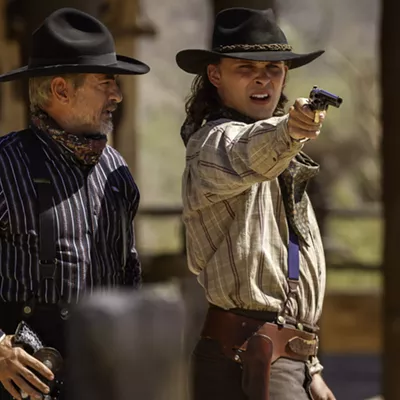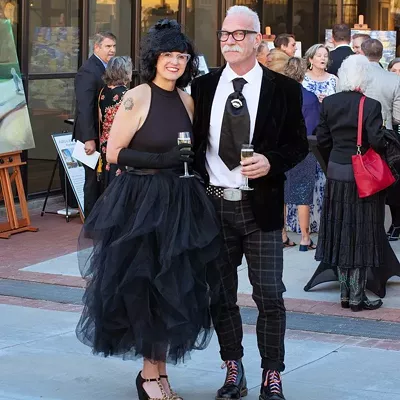Saints and sinners are the stars of Milagros, an exhibition that kicks off Saturday at Contreras Gallery, one of many opening in time for the holidays.
St. Christopher turns up in a painting by gallery co-owner Neda Contreras. The patron saint of travelers, St. Christopher once safely carried the boy Jesus across a river, or so the old story goes. Contreras sticks to this legend in her "Ex-Voto to St. Christopher" but she transports the saint from the Old World to the New, and places him firmly in the southern Arizona desert.
Christopher floats above our familiar landscape, hoisting baby Jesus on one shoulder, while gliding above five young Tucson hikers who cheerfully make their way across the sands. In the distance are the blue Tucson Mountains, and if you look hard you'll see a javelina, a mountain lion and a pair of bunny rabbits among the prickly plants.
Contreras, also known for charming paintings of Día de los Muertos skeletons, is one of 17 artists in Milagros—miracles.
"This show has been a tradition for us ever since the gallery opened," says Michael Contreras, Neda's spouse and gallery co-owner. "Our focus is on the cultures of the Southwest, Mexican culture included." The gallerists switched the popular exhibition from its usual August berth to take advantage of the Christmas crowds.
The invitational exhibition focuses both on ex-votos and retablos, mainstays of Mexican religious folk art, as interpreted by contemporary artists.
Ex-votos picture either a petition to a saint—or the results of an answered prayer. In the St. Christopher ex-voto, a lengthy prayer in English is painted right below the traipsing children.
"Dear St. Christopher," it begins. "Protect me today in all my travels along the road's way. Give your warning sign if danger is near..."
Retablos, by contrast, don't usually tell a story, Michael Contreras says. Instead they're straight-forward paintings of a saint or of Jesus or the Virgin Mary.
Milagros are traditionally painted on tin, and Michael distributed metal to the artists to use as a "canvas." And he made "pitched roof" frames for the works, and making them look like religious nichos that you might find in a Catholic church.
At press time, Michael had not yet see the finished pieces. But artist Lisa Kanouse, known for her jazzy paintings of downtown Tucson, was considering making a Virgin of Guadalupe retablo, he says. Rudy Flores intended to use his skills in 3-D printing to make an ex-voto, combining time-tested themes with modern high tech.
Contreras Gallery, 110 E. Sixth St. 398-6567; contrerashouseoffineart.com. Milagros opens with a reception 6 to 9 p.m., Saturday, Dec. 2; closes Jan. 27. 10 a.m. to 4 p.m., Tuesday through Saturday. Closed Sunday and Monday. No holiday closings.
A block east on Sixth Ave., Raices Taller 222 Gallery is debuting Chiquititos: An Exhibition of Small Works, at a Saturday night art party. The Latina/o-focused gallery issued an open call for works in all media, from paintings and sculptures to prints and photographs. The gallery's John Salgado was expecting 30 to 40 artists, each contributing up to three works. "There's no size limit, but the idea is smaller works and smaller prices," in time for the holidays, Salgado says.
On Tuesday, Dec. 12, the feast day of the Virgin of Guadalupe, Raices will host a "Christmas party for the Virgin, our mother," says the gallery's Ceci Garcia. "We'll have a little music and a potluck. And ask people to throw a dollar or two in the bucket."
Raices Taller 222 Art Gallery & Workshop, 218 E. Sixth St. 881-5335; raicestaller222.com. Chiquititos opens with a reception 6 to 9 p.m., Saturday, Dec. 2; closes Dec. 30. Regular hours 1 to 5 p.m., Friday and Saturday. No holiday closings.
A Tucson fabric artist opens Suzanne Hesh: Cursive, a solo show of fiber works, at the UA Poetry Center on Monday. And this being the Poetry Center, Hesh's work deals with language and words.
Her delicate—even poetic—works are both "writing- and textile-based," says Julie Johnson, library specialist, "but they're all different from one another. They're beautiful and fascinating."
You can't necessarily read Hesh's words. The embroidered curlicues and lines on some of these elusive pieces look like words, but aren't. Other times they form words that can be read, though with some difficulty. In the installation "First Person," for instance, dreamy word fragments and letters in black thread float against a wall. They seem to be like actual words, but you can't be entirely sure.
By contrast, "Manifesto in Red," a vertical cloth piece embroidered with elegant cursive letters in red, has words that can be read: "misogyny," "sexism," "indecency."
UA Poetry Center, 1508 E. Helen St., UA campus. 626-3765; https://poetry.arizona.edu/. Suzanne Hesh: Cursive opens Monday, during regular business hours; there will be no reception; closes Feb. 17. Gallery hours 9 a.m. to 8 p.m. Monday and Thursday; 9 a.m. to 6 p.m. Tuesday and Wednesday; 9 a.m. to 5 p.m. Friday; 10 a.m. to 2 p.m. Saturday. Closed Sunday. Closed for the holidays Dec. 23 to Jan. 1, reopening Jan. 2. Closed for Martin Luther King weekend, Jan. 13 to Jan. 15, reopening Jan. 16.
Henry Codax is a mysterious contemporary painter who has shown internationally, in New York, Paris, LA and Antwerp. Now the tiny year-old Everybody Gallery in Tucson has landed a show by Codax, whose bio thus far is an art-world secret.
Founded by three young UA art grads, including Christian Ramirez, late of MOCA, Everybody will exhibit large monochrome paintings in Henry Codax: Strawberry Lemonade. Each piece glows in a single brilliant color, including the yellow and magenta tones that give the show its name.
"Henry Codax is a monochrome painter in a very traditional sense," gallerist Alex von Bergen writes in an email. "All of his works are...in a single color rolled onto the canvas."
The pure, flat color is not interrupted by painterly marks or brushstrokes.
"They are essentially blanks," Codax has said, according to the press release, "with little evidence of the hand that made them."
Everybody Gallery, in Steinfeld Warehouse, 101 W. Sixth St., in Studio Q. 477-1754; http://everybody.gallery, opens Henry Codax: Strawberry Lemonade with a reception on Friday, Dec. 8, from 7 to 10 p.m. Music by DJ Bidegan Beats; refreshments. Show closes Jan. 17. Open by appointment, via info@everybody.gallery, Facebook and Instagram.
Holiday art strollers can also check out these already-opened shows in small galleries around town: Sabbatical at Bernal Gallery at Pima College West, through Dec. 8, an exhibition by hard-working art profs Christina McNearny, a mixed-media painter and ceramicist Hiro Tashima and three invited pals, pima.edu/cfa; Re: Markable at Conrad Wilde Gallery in the Steinfeld Warehouse through Dec. 16, a group show by five contemporary artist, conradwildegallery.org; and New Works from Hunting Studio Glassworks at Philabaum through Jan. 27, a show of brilliantly colored art glass by a father-son duo from Wisconsin.











